
 Tyler Kuehl
The Hockey Writers
Tyler Kuehl
The Hockey Writers
41
Reads
0
Comments
NCAA Hockey National Championship History: The 2010s
*This post is the seventh installment in a series that looks at the NCAA men’s ice hockey national champions, beginning with the 1940s. Here are the decades that have already been covered:
- NCAA Hockey National Championship History: The 1940s & 1950s
- NCAA Hockey National Championship History: The 1960s
- NCAA Hockey National Championship History: The 1970s
- NCAA Hockey National Championship History: The 1980s
- NCAA Hockey National Championship History: The 1990s
- NCAA Hockey National Championship History: The 2000s
Since the initial NCAA tournament in Colorado Springs in 1948, 72 programs have been crowned the best team in college hockey in the United States. Some have won more than others, but all are proud to be champions, even if it was only once.
The most recent decade of college hockey may not have had the same nationwide appeal as in years past. However, the action was just as good, if not better than ever before. Players who were in school one day made an immediate impact in the NHL the next. The decade saw some of the unlikeliest champions and a brand new dynasty in the Land of 10,000 Lakes.
2010: Boston College
The Boston College Eagles were riding high heading into the second decade of the 21st century. After winning championships in 2001 and 2008 and numerous Frozen Four appearances, the Eagles cemented themselves as one of the best programs in the country.
Related: Top 10 Hobey Baker Winners of All-Time
Heading into the 2009-10 season, BC had a lot of returning talent and some exceptional newcomers. The team played well for most of the regular season, going 21-10-3, and finishing second in the Hockey East standings. Cam Atkinson led the offensive charge, and hose 53 points tied him for third in the country.
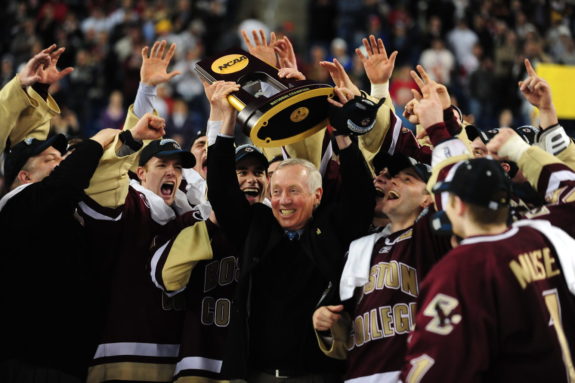
The Eagles won their ninth Hockey East championship and were given the top-seed in the Northeast Regional of the NCAA Tournament. After beating Alaska in the opening game, Atkinson’s hat trick helped Boston College eke out a 9-7 win over Yale to send them back to the Frozen Four.
The 2010 Frozen Four was played inside Ford Field in Detroit, making it the most attended Frozen Four in history. The Eagles made easy work of no. 1 Miami University to meet Wisconsin in the championship game. In front of a NCAA record-setting crowd of 37,592, Atkinson’s two goals and a 20-save peformance from goaltender John Muse helped the Eagles to a 5-0 win, and the school’s fourth national championship.
2011: University of Minnesota-Duluth
In 1984, the Bulldogs lost a quadruple-overtime classic to Bowling Green in what was their only championship game appearance. Since then, Minnesota-Duluth bounced around an extremely competitive WCHA but was never able to make it back to the promised land.
Something clicked, though, in the 2010-11 season. The Bulldogs started hot, winning 11 of their first 14 games. They dipped in the second half of the season, but still finished with a 20-9-6 record. Offensive depth was the key to their success. All-Americans Jack and Mike Connolly (no relation), along with Justin Fontaine, finished top-10 in the country in scoring with Jack Connolly scoring 59 points (3rd), Fontaine scoring 58 (4th) and Mike Connolly hitting 54 (T-7th).
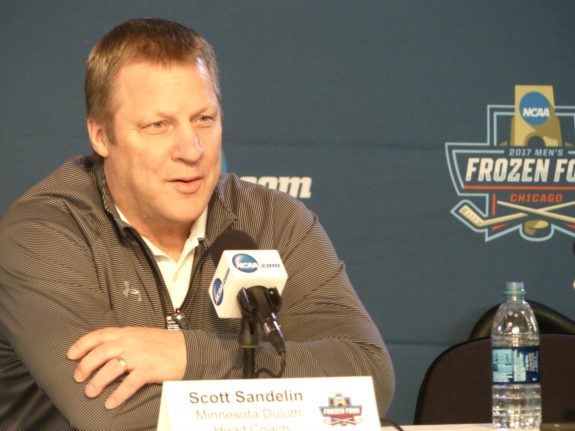
The Bulldogs were not heavy favourites heading into the national tournament, coming in as the no. 3 seed in the East Regional with an at-large bid. Yet, UMD squeaked out wins over Union and Yale (the no. 1 team in the country heading into the tournament), sending them to the Frozen Four for the first time in seven years.
A win over Notre Dame placed the Bulldogs against Michigan in the championship game. Despite that the odds favoured the Wolverines, it was the Bulldogs who played off the atmosphere at the Xcel Energy Center in St. Paul. UMD outshot the Wolverines 36-23 through three periods, but the game went to overtime tied at two.
Minutes into the extra frame, Travis Oleksuk found Kyle Schmidt open in front, and Schmidt tapped in his third goal of the tournament to give Minnesota-Duluth its first national championship (from ‘Schmidt relives angelic moment: Hermantown native scored goal that gave UMD its only national title,’ Duluth News-Tribune, 04/03/2018).
2012: Boston College
After a win in 2010, the Eagles felt good heading into the 2011 tournament. However, they were stunned in the first round by Colorado College, and Boston College entered the 2011-12 season looking for redemption.
Despite losing big-time players like Atkinson and Jimmy Hayes to the NHL, the Eagles ran through the competition during the regular season. The team finished the regular season as the no. 1 team in the country with a 25-10-1 record. Even though no player eclipsed 50 points, the Eagles still had an offensive punch in Chris Kreider and freshman Johnny Gaudreau who finished first and second in team scoring with 45 and 44 points, respectively.
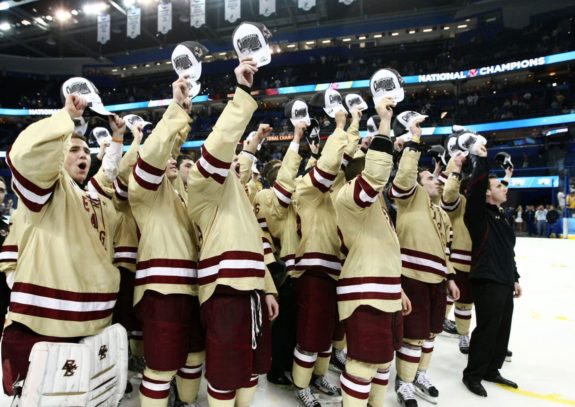
BC went on to win another Hockey East Conference Championship and entered the NCAA Tournament as the top team in the Northeast Regional. After defeating Air Force and defending champions Minnesota-Duluth, the Eagles punched their ticket to the Frozen Four for the 23rd time.
The Eagles trounced Minnesota in the semifinal, and met Ferris State, a school making its first-ever appearance to the Frozen Four, in the championship game. Both teams earned chances throughout the contest, but the veteran experience of the Eagles prevailed. Behind a pair of goals from Steven Whitney, and a 27-save outing from netminder Parker Milner, Boston College took home its second title in three years with a 4-1 win.
2013: Yale University
It was 24 years before college hockey saw a champion come out of the ECAC. With the mighty CCHA, Hockey East and WCHA controlling the charts, no ECAC had succeeded come tourney time.
That was, until the unlikely 2012-13 season.
The Yale Bulldogs had been a top team in the ECAC, with two regular-season titles and a conference championship in 2011. Yet, they had not made it to the Frozen Four since 1952.
Yale had a fairly mediocre season compared to the top teams in 2012-13, finishing with a 16-10-3, good for third in the conference. Kenny Agostino and captain Andrew Miller were the Bulldogs’ go-to guys and tied for the team-lead in points with 41 apiece. Miller was the lone Bulldog to receive a national individual award and was named Second-Team All-American.
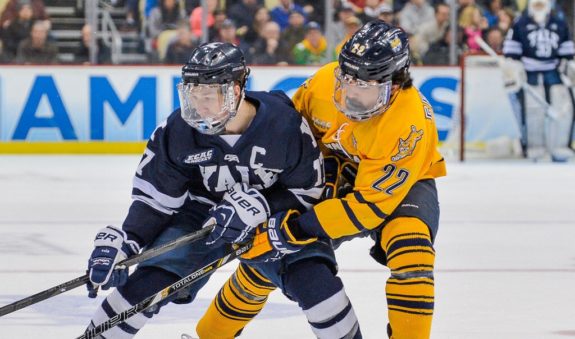
Even though they lost in the third-place game in the ECAC Tournament, Yale still made it into the national tournament, albeit as the four-seed in the West Regional. They shocked the college hockey world by beating top-seed Minnesota in the opening round and followed that up with a win over North Dakota to go to the Frozen Four for the first time in 61 years.
They met UMass-Lowell in the semifinal, and despite being huge underdogs once again, Yale won 3-2, outshooting the River Hawks 47-18 in the process.
This placed the Bulldogs against conference-rival, and no. 1 team in the country, Quinnipiac, in the final, the first all-ECAC final since 1978. The Bobcats earned the better chances throughout the game, but Yale goaltender Jeff Malcolm stood on his head, stopping all 36 shots. A goal in the second period for Yale followed by a trio in the third, with the help of Miller’s goal and assist, gave Yale its first title.
It marked the first time, under the current tournament format, that a four-seed won the national championship.
2014: Union College
After the craziness in the 2013 tournament, it only made sense to have another first-time champion, right?
The Union Dutchmen started to make a name for themself heading into the 2013-14 season. They won the previous two ECAC Tournaments and had clinched a spot in the 2012 Frozen Four. With plenty of veteran experience, the Dutchmen looked to have another run in 2014.
Related: 7 Cool Things About Johnny Gaudreau
However, Union stumbled out of the gate, going 3-3-2. They were able to bounce back, though, with a nine-game winning streak which set the pace for the rest of the regular season. They finished with a 24-6-4 record as the top team in the conference. Daniel Carr led the Dutchmen in scoring, finishing eighth in the country with 50 points. However, it was the blue line where Union really thrived, with Shayne Gostisbehere and Matthew Bodie both named First-Team All-Americans.
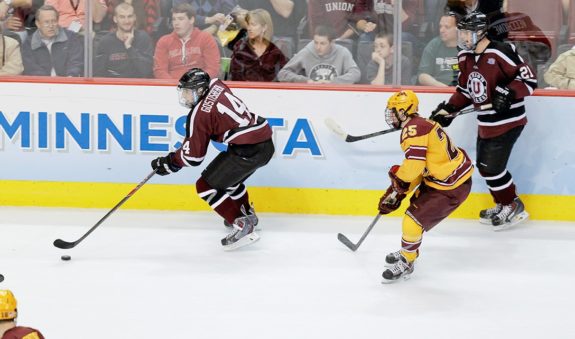
After winning their third-straight ECAC Championship, Union entered the national tournament as the best team in the country. They made their way through the East Regional with wins over Vermont and Providence, sending them back to the Frozen Four for the second time in three years.
The Dutchmen won a wild semifinal against Boston College, thanks to a hat trick from Daniel Ciampini. In the championship game, it was no. 1 versus no. 2, as Union met Minnesota. The game was a barn-burner, and Union scored four goals to the Gophers’ two in the opening 20 minutes. The Dutchmen went on to win 7-4, with seven different goal scorers to go along with Gostisbehere’s three-point night, and Union was crowned national champions.
2015: Providence College
How about another first-time champ?
The Providence Friars had a competitive hockey program inside both the ECAC and Hockey East. Before the 2014-15 season, they had made it to the Frozen Four three times, including the 1985 championship game.
The Friars had an exceptional regular season in 2014-15, going 21-11-2, and finished second in the Hockey East standings. Defence was the name of the game for Providence, as no player reached the 40-point mark. Jon Gillies was the star in net, and his .930 save percentage (SV%) was in the top-five in the country, and he tied for fifth in shutouts with four.
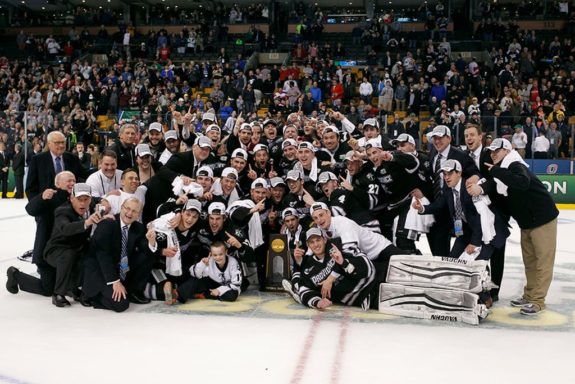
Despite the great regular season, the Friars were knocked out of the first round of the Hockey East Tournament by New Hampshire and were forced to enter the national tournament as the no. 4 seed in the East Regional. Thankfully, it was in the Friars’ backyard at the Dunkin’ Donuts Center in Providence.
Providence outlasted Miami in a wild 7-5 game, before taking down Denver to go to the Frozen Four in Boston. A win over Nebraska-Omaha set up an all-Hockey East final between the Friars and Boston University, that year’s Hockey East Regular Season and Conference Champs.
The crowd at the TD Garden was a heavy mix of Terrier and Friars fans, making it a great atmosphere for a championship game. The play went back and forth, as Providence scored first, but the Terriers came back and took a 3-2 lead heading into the third period.
Then, BU goaltender Matt O’Connor gave up. The. Worst. Goal. Ever.
Tom Parisi’s 100-ft goal tied the game, and Brandon Tanev scored minutes later to send the Friars on their way to a national championship.
2016: University of North Dakota
It felt like a long time since North Dakota (now called the Fighting Hawks) had won a national championship, their most recent was in 2000.
The 2015-16 Hawks were a team built to succeed, and they showed it. The club won six of their first eight games, and, after American Thanksgiving, only lost three of their remaining 23 games. They finished with a 28-5-3 record and were crowned National Collegiate Hockey Conference (NCHC) Regular Season Champion. The Hawks were stacked offensively, with All-American freshman Brock Boeser leading the charge with 60 points, good for third in NCAA in scoring.

Even though the Hawks were unable to win the NCHC Conference Championship, they still entered the national tournament as the top-seed in the Midwest Regional. After convincing wins over Northeastern and Michigan, North Dakota was going back to the Frozen Four for the third year in a row.
After defeating now-NCHC rival Denver in the semifinals, North Dakota met Quinnipiac in the championship game. Led by a pair of goals from Drake Caggiula, and a goal and three assists from Boeser, the Fighting Hawks won their eighth national title by a final score of 5-1.
2017: University of Denver
The 2010s saw the rise of a new powerhouse conference, and after North Dakota’s success in 2016, established programs such as Denver helped take NCHC to new heights.
The Pioneers’ 2016-17 season was one of the program’s best. Despite losing their first two games of the regular season, Denver took off and proved to be the top team in the NCAA. DU finished with a 26-6-4 record and clinched the NCHC Regular Season Championship. Troy Terry and All-American Henrik Borgstrom led the attack for the Pioneers, leading the team with 45 and 43 points, respectively. Defenceman Will Butcher also chimed in with 37 points and became the second DU player to win the Hobey Baker Award.
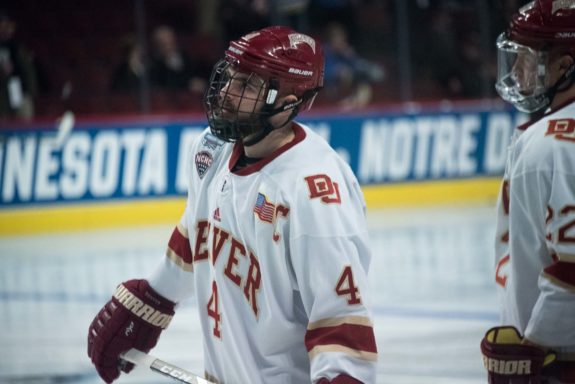
Denver was knocked out of the NCHC by North Dakota, but still entered the national tournament as the best team in the country. They made their way out of the Midwest Regional with convincing victories over WCHA-champion Michigan Tech and Big Ten Champ Penn State, sending DU to the Frozen Four for the 15th time.
After dominating Notre Dame, the Pioneers went up against NCHC Tournament-champion Minnesota-Duluth in the final. Jared Lukosevicious led the Denver offence with a hat trick. The Bulldogs brought the house down on Pioneer netminder Tanner Jaillet, but the Mike Richter Award-winner shut the door, stopping 38 of the 40 shots. The Pioneers held on to win their eighth national championship by a final score of 3-2.
2018: University of Minnesota-Duluth
The disappointment of falling one goal short in the championship game weighed on the Bulldogs heading into the 2017-18 season. Considering that UMD lost five of its top six scorers and starting goaltender Hunter Miska, many thought it was going to be a down year for the Bulldogs.
Yet, Minnesota-Duluth proved they were still an exceptional team. They hung around the top-10 and ended the regular season with a 19-14-3 record. They did drop to third in the NCHC thanks to their 13-11 record in conference action. While no Bulldog hit 40 points that season, freshman blueliner Scott Perunovich stood tall, leading Minnesota-Duluth with 39 points. Goaltender Hunter Shepard was one of the best in the crease, with a 1.91 goals-against average (GAA), ranked sixth in the country, and a .925 SV% that was in the top-10 among NCAA netminders.

The Bulldogs did not win the NCHC Tournament, falling in the conference semis to Denver. However, they still clinched a spot in the national tournament as the no. 3 seed in the West Regional. The Bulldogs had to squeak out an overtime win against Minnesota State, before winning a tight battle against Air Force, to make it back to the Frozen Four.
Back in St. Paul, where the Bulldogs won their first championship seven years prior, the team knocked off Ohio State in the semis to meet with Notre Dame in the championship game. UMD controlled the play throughout the contest, outshooting the Fighting Irish 35-20. They only got a pair passed Notre Dame goaltender Cale Morris, but it proved to be enough as the Bulldogs won their second championship by a final score of 2-1 (from ‘As graduation nears, former Colorado youth hockey star Cale Morris awaits NHL future,’ Denver Post, 05/11/2020).
2019: University of Minnesota-Duluth
With a plethora of returning talent, there was talk that the Bulldogs had a chance at back-to-back championships, entering the 2018-19 season as the preseason no. 1 team.
Minnesota-Duluth hung around the top-five for the most of the regular season and finished with a 21-11-2 record, good for second in the NCHC. Similar to previous seasons, the Bulldogs had no superb standouts on offence. Justin Richards and Parkey Mackay led UMD with 31 and 30 points, respectively. Shepard was outstanding in goal once again, earning First-Team All-American honours. Along with his .923 SV%, Shepard’s 1.76 GAA was tied for third in the country.
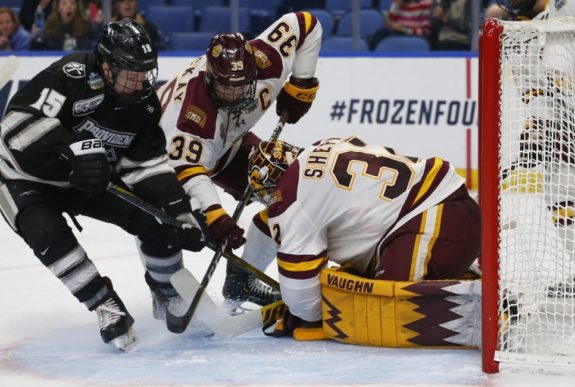
The Bulldogs won their second NCHC Conference Championship after defeating no. 1 St. Cloud State, and entered the national tournament as the top team in the Midwest Regional. Bowling Green pushed UMD to overtime in the opening round, but the Bulldogs survived and after a win over Quinnipiac, they punched their ticket to the Frozen Four for the third consecutive season.
Minnesota-Duluth beat Providence in the semifinal, setting up a meeting between them and UMass, and Hobey Baker-winner Cale Makar, to decide the championship game. Similar to their win in 2018, the Bulldogs dominated the contest, almost outshooting the Minutemen by a 2:1 margin. Shepard stopped all 18 shots he faced, and Mikey Anderson’s three-point night helped the Bulldogs become only the fifth school to win back-to-back championships.
There you have it, the breakdown of the 72 NCAA Hockey National Champions, and a tidbit of the stories and facts of the teams that were crowned the best in college hockey. From humble beginnings in the 40s and 50s to national appeal in the 21st century and beyond, college hockey has been able to show off the best talent in amateur hockey for well over 50 years. Despite not having a champion in 2020, I cannot wait to see what the next decade will hold.
The post NCAA Hockey National Championship History: The 2010s appeared first on The Hockey Writers.
Popular Articles

















































 Blackhawks Chicago
Blackhawks Chicago Panthers Florida
Panthers Florida Penguins Pittsburgh
Penguins Pittsburgh Rangers New York
Rangers New York Avalanche Colorado
Avalanche Colorado Kings Los Angeles
Kings Los Angeles Maple Leafs Toronto
Maple Leafs Toronto Bruins Boston
Bruins Boston Capitals Washington
Capitals Washington Flames Calgary
Flames Calgary Oilers Edmonton
Oilers Edmonton Golden Knights Vegas
Golden Knights Vegas Islanders New York
Islanders New York Sabres Buffalo
Sabres Buffalo Red Wings Detroit
Red Wings Detroit Flyers Philadelphia
Flyers Philadelphia Senators Ottawa
Senators Ottawa Lightning Tampa Bay
Lightning Tampa Bay Devils New Jersey
Devils New Jersey Hurricanes Carolina
Hurricanes Carolina Blue Jackets Columbus
Blue Jackets Columbus Predators Nashville
Predators Nashville Wild Minnesota
Wild Minnesota Blues St. Louis
Blues St. Louis Stars Dallas
Stars Dallas Jets Winnipeg
Jets Winnipeg Mammoth Utah
Mammoth Utah Sharks San Jose
Sharks San Jose Canucks Vancouver
Canucks Vancouver Ducks Anaheim
Ducks Anaheim


